This page contains kanji
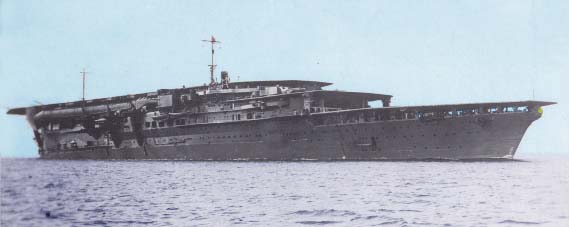 |
 |
| Kaga | Reformed Kaga |
 |
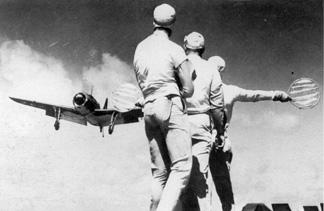
|  |
| USN LSO | light array |
Koku Bokan no Hacchaku Shien
 | 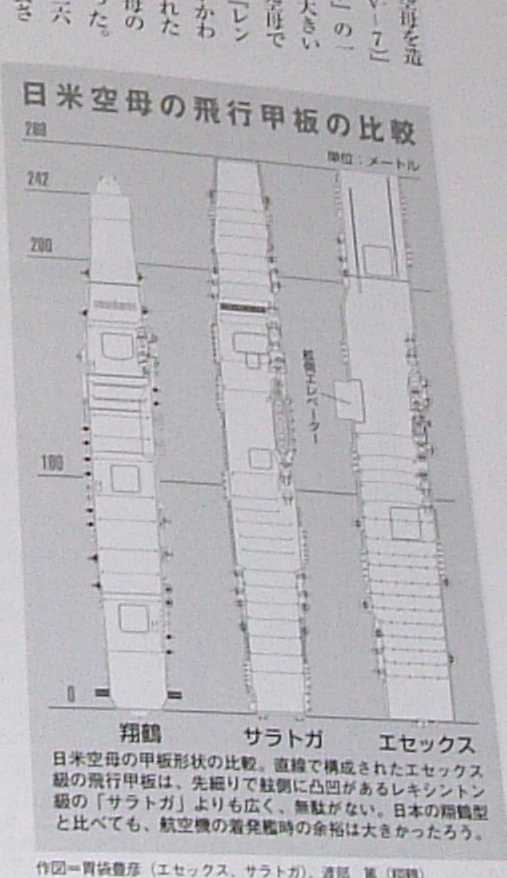 |
| Launch time table | Flight decks |
IJN and USN began design of new class of fleet type aircraft carrier almost at the same time just after the end of Washington Treaty. IJN launched Syokaku class a year eariler than USN Essex class. While USN ordered building 22 aircraft carrier Essex class on 3 July 1940. US decided war in the Pacific. Because Germany and Italian naval air force was negligible. Japan had to win the Pacific War before USN Essex class aircraft carriers launched. Strangely IJNGS planned building only 3 regular aircraft carriers in spring 1941, and 18 aircraft carriers on 30 June 1942, waking up the defeat of Midway[2]. USN launched 6 aircraft carriers of Essex class in 1943, while IJN launched only one light aircraft carrier in the same year. The left time table shows them. No1 horizontal line of the time table means the Midway battle. Also No2, No3, No4 means the south Pacific, the Mariana and the Phillipines battle each.
The drawing of top view shows both of the side elevator and the landing device. Although both of them were almost the same displacement, Essex class had a wider flight deck than Syokaku class. But USN invented side elevator which was efficient while landing or taking off. Otherwise IJN invented light array landing device equipped at stern. So you can see much arresting wires of Essex class than Syokaku class. Lady Sarah was equipped with arresting wires even aft. The Essex class was equipped with 2 new type catapults bow.
Gunzo p83-88, No76
Syokaku gata kokubokan ni kansuru sasaina kodawari
Design History
Essex Class Aircraft Carrier Data
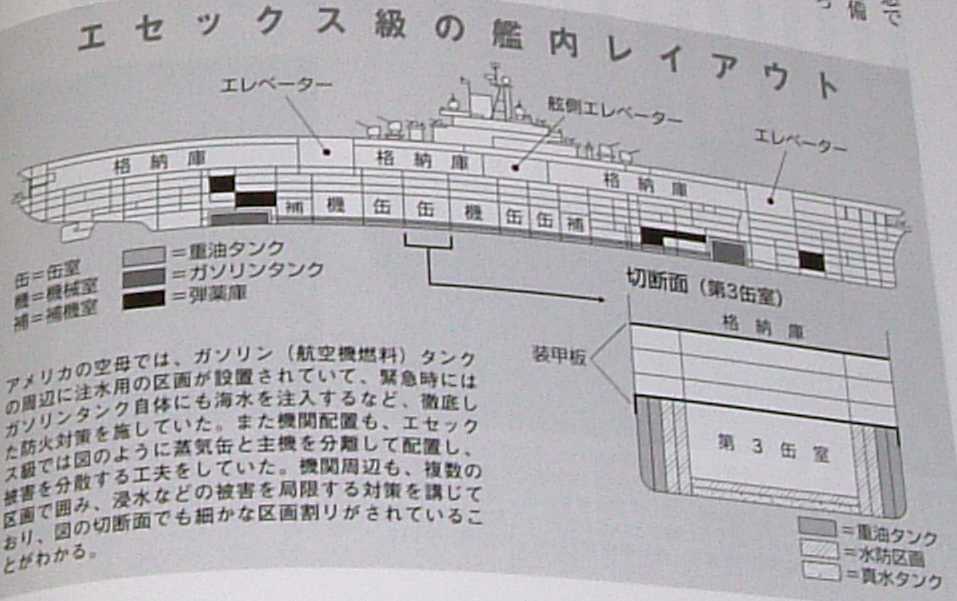 | 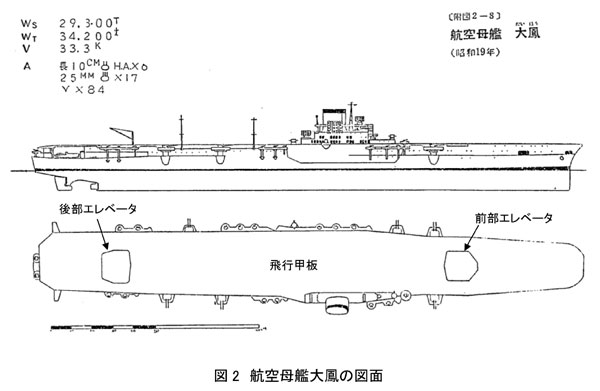 |
| Layout of Essex class | IJN Taiho |
IJN armored aircraft carrier, Taiho exploded because of leaked gaseous aviation fuel in the Mariana Battle. The explosion destroyed fire control equipment. It could not cease fire as Akagi and Kaga in the Midway Battle. Taiho's keel was laid down at Kobe of Mitsubishi in July 1941 and Taiho was comissioned on 7 March 1944. The Essex class could fill water in an aviation fuel stowage in a case of emergency, if the fire control equipment endured after explosion. The drawing shows the lay out of Essex class. The two gray painted parts at the bottom of the hull were the stowages of aviation fuel. How did IJN try controlling fire?
| Battle | Countermeasure |
| Midway | Filled water outside of stowages of aviation fuel |
| Mariana | Made bulge outside of stowages of aviation fuel and filled concrete Closed pipes of empty stowage of aviation fuel Powered up ventilation of hangar[1] |
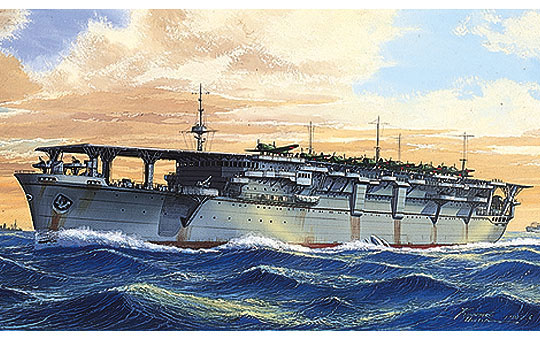 |
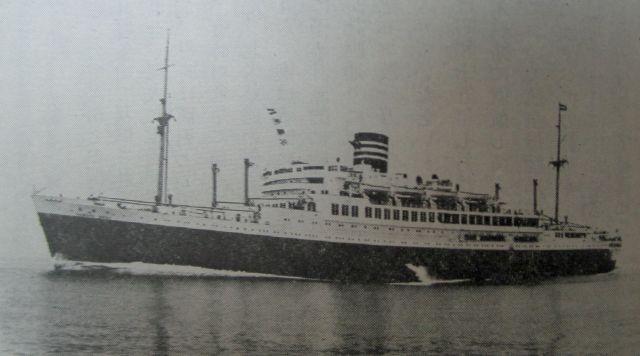
|
| IJN Unyou | Before Unyou |
-
1940Aug26 Seattle
1940Nov11 San Francisco
1940Dec24 εA
1941Feb04 San Francisco
1941Apr08 San Francisco
1941Jun18 San Francisco[3]
-
I remember that San Francisco was a typical city of the North America among Japanese people. We said, "Hana no San Francisco" It meant San Francisco is like flower. I also remember a phrase of old American pop. "If you are going to San Francisco..." Most people adored San Francisco than New York. San Francisco was a gate to the US for Japanese people for a long time. But Los Angeles is a typical US city now. She looks a city of violence and drug for Japanese commons.
The Pacific War was to get air control of isolated airbases whether Japan or US won air battles. Both IJN and USN prepared for merchant ships to rebuild for them at the same time. USN rebuilt USS Long Island for 88 days only. RN spent 6 months to rebuild HMS Audacity. IJN spent a year and half to rebuild Jyunyo which was originally a big cruising merchant ship of 27,000 GT. Jyunyo worked well at the South Pacific Battle on 27 October 1942. RN began rebuilding German merchant ship Hanover for an auxiliary aircraft carrier in January 1941. Looking up the dates when RN and USN launched escort aircraft carriers at peak, RN was in August 1943 and USN was in June 1944. Both UK and US would think the win of the Atlantic and the Pacific each then. Halsey reported Stark to rebuild auxiliary aircraft carriers in December 1940.
Gunzo, p107, No.45
Goeikubo, p111-116
-
Sangamon class
USN rebuilt 4 T2 type oilers of 10,100 gross ton as auxiliary aircraft carriers. The first USS Sangamon (CVE-26) was recommisioned on 25 August 1943. It took half a year to rebuild her. The Sangamon was equipped with a new type radar which was capable for precise intercepting enemy aircraft. Aircarft Squadrons changed -37 from -26. USS Sangamon, CVE-26 did CAP 50 mile in the south of Okinawa. She moved to Sakishma Islands to attend air raids of Miyako Island on Apr 9th and 18th.
USS SANGAMON (ACV-26)
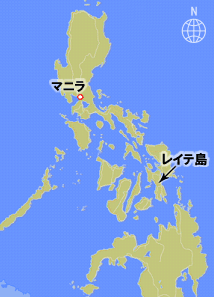 | 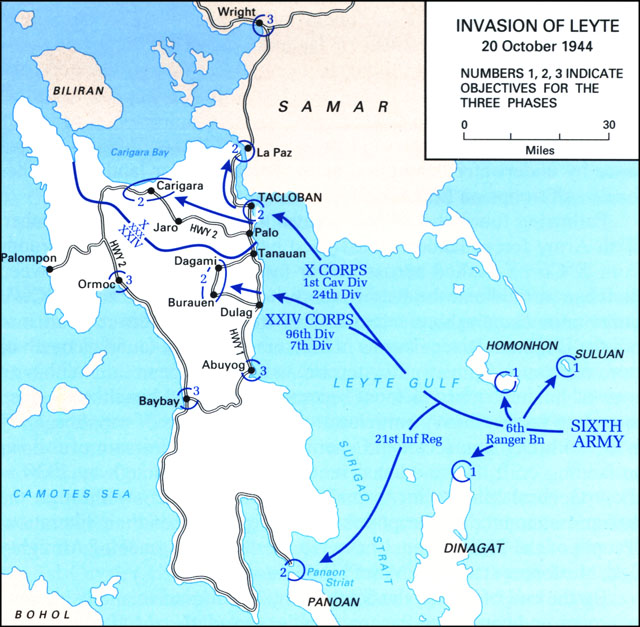 |
| Philippines | Leyte |
14 CVEs of the Casablanca class worked as CAP of Task Force 77. Other 8 CVEs worked as aircraft suppliers of fast aircraft carriers strike force. The 7th fleet and 3rd fleet of USN also were to cooperate the operation for the first time. 18 CVEs took part in the landing operation. Standard composite squadron had 16 FM-2 and 12 TBM-1. All the FM-2 of the both fleets were 247. Japan saw landing troops comming to Leyte on October 17, and ordered Operation Syo-1 on 19. USA began to land on October 20. However, intercepting fleet and aircraft of IJN delayed in action on 22. C. Sprague of 6 CVEs and 3 destroyers, and 4 destoryers escorts showed excellent tactics in the battle. While destroyers of IJN would not dash. Kurita told he was anxious about shortage of fuel of the destroyers, though Ugaki wrote the battleships should supply the destroyers with fuel. I do not think gun fires of battleships crashed the convoy if Kurita assalted the Leyte Bay. Because Nishimura's fleet had been destroyed, Kinkaid's fleet had half finished ammunition while Kurita chased 6 escort aircraft carriers of Taffy Three. I think he could intercept Kurita's hurt 4 battleships, 3 heavy cruisers and 2 destroyer squadrons. Actually aircraft of escort carriers had downed already 3 heavy cruisers of Chokai, Chikuma and Suzuya.
Ebina, p313
F4F, p53
Most of Japanese people criticized Kurita's decision to give up the assalt. I think they ignoring remained escort aircraft power. We remember 4 F4F stopped IJN amphious operation at the Wake Island. They write escort aircraft carriers of Task 77 were not equipped with torpedos or AP bombs and the aviators had not trained against surfaced vessels. I do not think so. We ignored USN ammunition and refuel ability on surface. How were the escort carriers really? Taffy 1 was in the south of Taffy 3. Thomas L. Sprague commanded Task Group 77.4 Escort Carrier Group.
-
Taffy 1: Rear Admiral Thomas L. Sprague in Sangamon
USS Sangamon (CVE-26) Early on 25 October, two flights took off: one toward the Mindanao Sea to locate and finish off Japanese survivors of the Battle of Surigao Strait, the other toward Leyte for CAP missions. About an hour later, Sangamon received word that Taffy 3, 120 miles (190 km) to the north. Within a half hour, Sangamon's CAP flight had been diverted to Samar and she had launched another smaller, group to further aid the attacked unit. Soon thereafter, however, at about 0740, as Taffy 1 planes were being recovered, rearmed, and launched, the unit became the target of the first strike of the kamikaze.
Santee took the first hit, and as her flight and hangar decks blazed, Suwannee was attacked. Antiaircraft fire from that CVE scored on the planes, which then dived toward Sangamon. A 5-inch (130 mm) shell from Suwannee finished one plane only 50 yards (46 m) from Sangamon. By 0755, Japanese submarine I-56 (2) had joined the fight, and, as Santee's crew brought her fires under control, sent a torpedo into that luckless CVE. Minutes later, Suwannee was hit by a Zero forward of the after elevator.
Later in the morning, as the attacks fell off, she sent medical personnel to assist casualties of the damaged ships, then began bringing them aboard for treatment. At mid-day, she suffered malfunctions in her steering gear, electrical generators, and catapult, but repairs were completed in time for her to launch afternoon strikes as scheduled.
On 26 October, Sangamon recovered her scattered planes and again launched CAP flights. At 1215, however, enemy planes were reported coming in from the north. Several broke through the air defenses, and Suwanee suffered another kamikaze hit. On 29 October, the escort carriers retired.
USS Suwannee (CVE-27) Suwannee was much farther south as an element of Rear Admiral Thomas Sprague's "Taffy 1". Consequently, she did not participate in the running surface battle off Samar. At 07:40 on the 25th, "Taffy 1" was jumped by land-based planes from Davao in the first deliberate suicide attack of the war. They hit the enemy, but he rolled over, dove at Suwannee and crashed her about 40 feet forward of the after elevator, opening a 10-foot hole in her flight deck. His bomb compounded the fracture when it exploded between the flight and hangar decks, tearing a 25-foot gash in the latter and causing a number of casualties. Within two hours, her flight deck was sufficiently repaired to enable the escort carrier to resume air operations. Suwanee's group fought off two more air attacks before 13:00; then steamed in a northeasterly direction to join Taffy 3 and launch futile searches for Kurita's rapidly retiring force. Just after noon on 26 October, another group of kamikazes jumped Taffy 1. A Zero crashed Suwanee's flight deck and careened into a torpedo bomber which had just been recovered. The two planes erupted upon contact as did nine other planes on her flight deck. The resulting fire burned for several hours, but was finally brought under control. The escort carriers put into Kossol Roads in the Palaus on 28 October, then headed for Manus for upkeep on 1 November.
USS Chenango (CVE-28) Chenango was not in action waters during the Battle of Leyte Gulf, but returned 28 October to provide replacement aircraft to her victorious sister escort carriers, who had held the Japanese fleet off from Leyte. The next day, she sailed for overhaul at Seattle, Washington, until 9 February 1945.
USS Santee(CVE-29) At 07:36 on 25 October, Santee launched five Avenger and eight Wildcat aircraft for an attack against Japanese surface units some 120 miles to the north. At 07:40, a Japanese plane made a suicide dive on Santee with an estimated 63 kilogram bomb, crashing through the flight deck and stopping on the hangar deck. At 07:56, a torpedo fired from a Japanese submarine struck the ship, causing flooding of several compartments and a six degree list. Emergency repairs were completed by 09:35.
USS Petrof Bay (CVE-80) From 21 October through 24 October Petrof Bay launched Air Support Groups. Two special strikes from Petrof Bay joined in the air attack against these enemy ships. Four FM-2 Wildcats and six TBM Avengers were launched at 0724 to join a 0552 launch of four fighters redirected to attack the Japanese surface ships. At 0729, RADAR reported six Japanese Mitsubishi A6M Zeros closing on the formation. The ship went to General Quarters and so remained for the next 108 hours. Wildcats without enough fuel to return to Petrof Bay landed at Tacloban airfield where the received some friendly fire. Surviving Avengers landed on Fanshaw Bay of Taffy 3 and Ommaney Bay of Taffy 2 with less than ten gallons of fuel remaining. Only one torpedo plane and two fighters returned to Petrof Bay. Petrof Bay launched a final strike at 1530 to search for and attack the enemy then in retreat. After rendezvousing with other aircraft from the CVEs, the flight proceeded to San Bernardino Strait where it found and attacked a cruiser of the Mogami class, scoring two torpedo hits and one probable hit. These planes also landed at Tacloban Airfield when their fuel was inadequate to return to Petrof Bay. At 2232, one of the destroyers in the screen had a sound contact. A 90-degree emergency turn was made and almost immediately thereafter two torpedoes straddled Petrof Bay, one twenty yards on the port and the other passing under the overhang on the starboard side. Coolbaugh attacked with depth charges and was believed successful in destroying the submarine. On 26 October, the only remaining Japanese force within range of the CVE's aircraft was one light cruiser and four destroyers sighted in the Visayan Sea. Petrof Bay launched its only two remaining torpedo-bombers to participate in a strike against the five ships. One plane scored a hit with a 500 pound semi-armor piercing bomb and a near miss on the cruiser and strafed a destroyer which caught on fire and blew up.
USS Saginaw Bay (CVE-82) As the Japanese Fleet closed, on 24 October, she was ordered to transfer her aircraft to other carriers and proceed to Morotai for replacements. Thus, she missed the Battle for Leyte Gulf. She rejoined her task unit on 28 October as it retired to Manus.
Taffy2: Rear Admiral Felix B. Stump in Natoma Bay
USS Manila Bay (CVE-61) Manila Bay launched two airstrikes during the enemy pursuit of Taffy 3 and two more as the Japanese retreated. At 0830, she sent four torpedo-laden TBM Avengers and a seven-plane escort to join the desperate fight. Three launched torpedoes at a battleship, probably Yamato, but they missed. The fourth plane launched her torpedo at a heavy cruiser, most likely Chikuma. It hit the ship to starboard near the fantail, forcing her out of control. The second strike an hour later by two Avengers resulted in one torpedo hit on the portside amidships against an unidentified battleship.
As the Japanese ships broke off attack and circled off Samar, the airstrikes continued. At 1120, Manila Bay launched four Avengers, carrying 500 pound bombs, and four bombers from other carriers. Escorted by FM-2 Wildcats and led by Commander R. L. Fowler, they soon joined planes from other Taffy carriers. Shortly after 1230, some 70 planes surprised and attacked the retiring Center Force, strafing and bombing through intense antiaircraft fire. Manila Bay's bombers made a hit and two near misses on the lead battleship, probably Kong‘¦or Haruna. Manila Bay launched her final strike at 1245, strafing destroyers and getting two hits on a cruiser.
Later that afternoon, Manila Bay's CAP intercepted a Japanese bomber-fighter strike about 50 miles north of Taffy 2. Her four fighters broke up the enemy formation, and with reinforcements drove off the attackers before they reached the carriers. Her planes continued to attack enemy ships the following day. Laden with rockets and bombs, one of her Avengers scored two hits on Kinu and several rocket hits on Uranami. Both ships sank about noon in the Visayan Sea after numerous air attacks.
Manila Bay resumed air operations in support of Leyte ground forces on 27 October.
USS Natoma Bay (CVE-62) At 07:02, "Taffy 2", 20 miles to the south-south-east, responded and by 0708 all available planes were en route. Those already dispatched on routine missions were recalled. In a running battle which ensued, the determination of self-sacrificing destroyers and destroyer escorts of "Taffy 3" and fighters and bombers of the three Taffies resulted in an almost unbelievable, but necessary, victory in the Battle off Samar. Ordered not to concentrate on any particular ship, but to cripple as many as possible, planes from Natoma Bay conducted two strikes against the enemy within an hour and a half. At 09:26 a third strike, with 500 pound SAP bombs in lieu of torpedoes, was launched. At 11:18, a fourth strike was sent off to push the maneuvering enemy away from Leyte Gulf, but with neither torpedoes nor armor piercing bombs aboard, the planes took off carrying only general purpose bombs and depth charges. At noon, Natoma Bay's fighters, launched previously for CAP, were landed, rearmed and sent up again. At 12:56 and at 15:08, the 5th and 6th strikes were launched to further pursue the enemy as it retreated toward San Bernardino Strait. Fighter planes, armed with 250 pound (113 kg) general purpose bombs, were among those dispatched with the last strike. The following morning, 26 October, Natoma Bay's planes, continuing to pound the enemy, assisted in the sinking of a light cruiser and her accompanying destroyer in the Visayan Sea and then resumed support of ground forces on Leyte.
USS Kadashan Bay (CVE-76) Arriving there 21 October she immediately commenced raids and strikes in support of troops ashore. Four days later one of her patrol planes, piloted by Ensign Hans L. Jensen, sighted the Central Force of the Japanese fleet off Samar. After reporting his sighting he launched an unsupported attack against the leading cruiser, beginning the famous battle off Samar. The carrier's air group launched three fighter and three torpedo strikes against Kurita's force.
USS Marcus Island (CVE-77) Beginning on 18 October, she launched airstrikes against enemy positions and during the next week, her pilots flew 261 target and air cover missions. One TBM Avenger put a torpedo into the portside aft of a heavy cruiser, probably Chikuma. Amidst intense antiaircraft fire, her fighters made repeated strafing runs against battleships, cruisers, and destroyers. Her planes joined in two strikes against the retreating Japanese ships that afternoon.
USS Savo Island (CVE-78) On the morning of the 25th, an escort carrier force off Samar, "Taffy 3", some 20 miles to the north, reported a large enemy surface force. The escorts of Savo Island's group also came under fire for about 30 minutes, as the carrier launched a total of six strikes in a desperate and successful effort to protect herself and the other carriers from annihilation.
USS Ommaney Bay (CVE-79) the escort carriers began launching air strikes in an effort to cripple as many of the approaching enemy force as possible. In the ensuing battle aircraft from Ommaney Bay contributed to the sinking of one Japanese cruiser and helped to damage a number of other warships. Ommaney Bay launched some six strikes that day.
Japan had already lost 1,000 aircraft preparing for Syo-1. GF might had better stop the opration. If 7 battleships stayed in the south, USN pay attention, as Royal Navy was anxious for hiding Italian or German warships. IJN lost valuable destroyers of Michishio, Asagumo, Yamagumo, Hatsuzuki, Akizuki, Nowake in the battle of Leyte. How should IJN use battleships and cruisers in the late Pacific War? The battleships always ran escorted by destroyers because they were afraid of allied submrines and spent much fuel. None of Yamato, Nagato, Haruna, Ise and Hyuga stayed at Singapore after the Leyte Battle. Kure Arsenal repaired Yamato and Haruna, though it was short of materials of steel or welding gas in November 1944.
| Distance | Azimuth | |
| Biak to Morotai | 937km | 292° |
| Morotai to Tacloban | 1,078km | 340° |
USAAF could not use Tachloban rainy bad weather enough. US Army suspended Mindro campaign for 10 days. The USN 3rd Fleet helped ground operation for 28 days longer than schedule and would rest in November.[7]
| Name | Size | Speed | Gasoline | Aircraft | Fuel/aircraft |
| USN Casablanca | 15,400t Gross | 19.3t | 100,000gal 26.5kL | 34 | 0.78kL |
| USN Yorktown | 19,900t Displ. | 32.5kt | 187,000gal 49.5kL | 72 | 0.69kL |
| Franklin D. Roosevelt CV-42 | 45,000t Displ. | 33kt | 350,000gal 92.6kL | 137 | 0.68kL |
| IJN Ryujo | 27,000t Gross | 25.2kt | 47,000gal 12.4kL | 48 | 0.26kL |
| HMS Ark Royal | 22,000t Displ. | 31kt | 120,100gal 31.8kL | 54 | 0.59kL |
Koei p.95
Ouchi p.113, p232
Ei-kubo no sinjitsu (1918-1941)
USS Kitty Hawk, CVA-63 loaded 7,828t for herself running and 5,882t for aircraft. The 5,882t is equivalent to 6,356kL
Kokubokan(Kubo) 4
Unit conversion
Aircarft fuel capacity of Ryujyo was smaller than Casablanca. And IJN always worried about shortage of oilers. Fuel capacity of USN FDR is too small, and Kitty Hawk is too large. I think both of the data are wrong.
Fuel tanks in Kwajalein Atoll
US Army built 2 tanks of 50,000 barrel and 14 tanks of 10,000 barrel after Mar 1944. The total was 190,000 barrel equivalent to 40,560kL
Gunzo, p.121 No.28
USS Long Island(CVE-1)
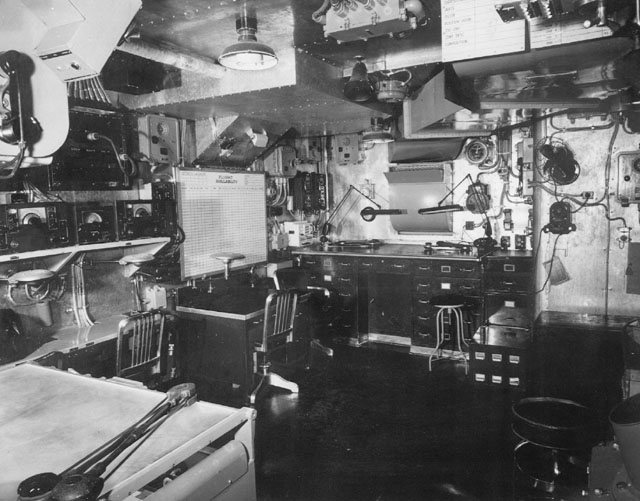 | 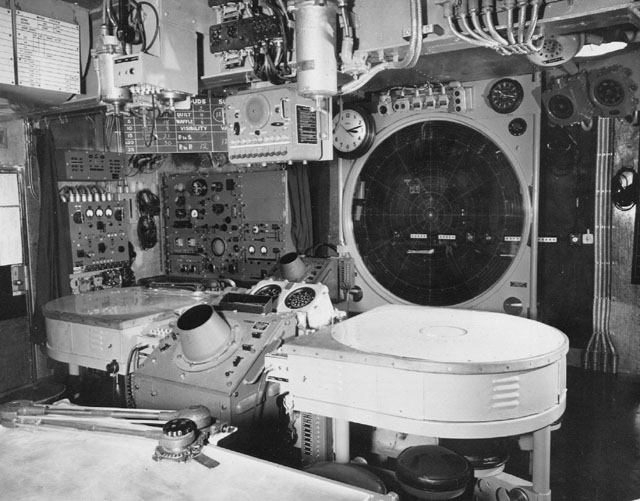 | 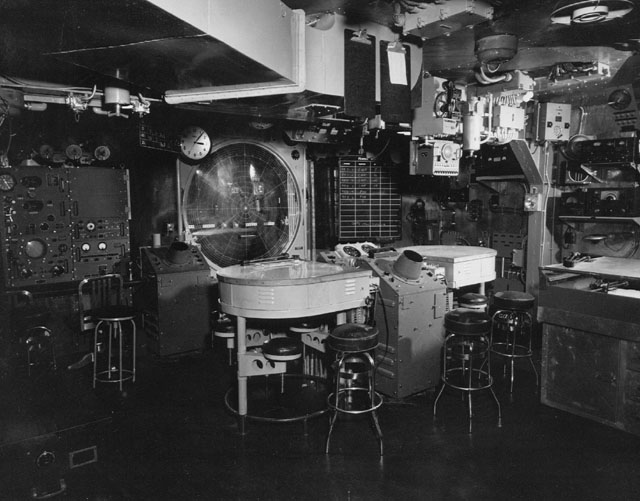 | 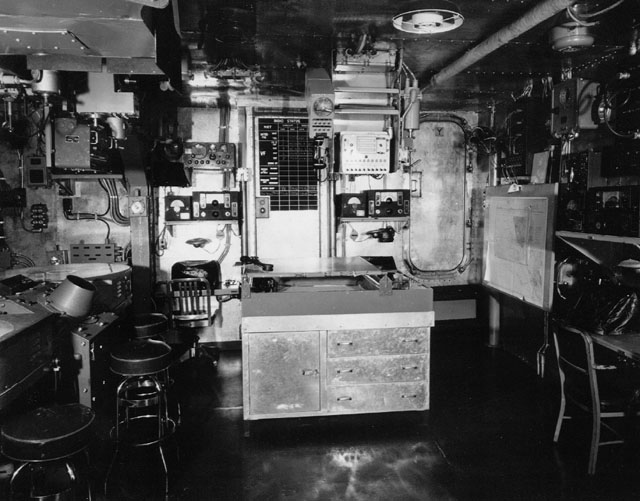 |
| Desk | Ploting screen | Radar scope | Hatch |
| Commissioned | Name | Laid down | Notable mission |
| 1927Nov16 | Saratoga (CV-3) | 1920Sep25 | Raided Rabaul |
| 1938May12 | Enterprise (CV-6) | 1934Jul16 | Tokyo raid:CAP |
| 1941Aug08 | IJN Shoukaku | 1937Dec12 | Raided Pearl Harbor |
| 1941Sep25 | IJN Zuikaku | 1938May25 | Raided Pearl Harbor |
| 1941Oct20 | Hornet (CV-8) | 1939Sep25 | Tokyo raid |
| 1942Dec31 | Essex (CV-9) | 1941Apr28 | Rabaul raid |
| 1943Jan14 | Independence (CVL-22) | 1941May01 | Rabaul raid: CAP |
| 1943Feb25 | Princeton (CVL-23) | 1941Jun02 | Rabaul raid |
| 1943Mar31 | Belleau Wood (CVL-24) | 1941Aug11 | Air support on Baker Island |
| 1943May24 | Bunker Hill (CV-17) | 1941Sep15 | Rabaul raid |
| 1943May28 | Cowpens (CVL-25) | 1941Nov17 | Air strikes on Mille and Makin |
| 1943Jun17 | Monterey (CVL-26) | 1941Dec29 | Strikes on Kavieng, New Ireland |
| 1943Jul24 | Cabot (CVL-28) | 1942Mar16 | Strikes on Roi, Namur |
| 1943Aug16 | Intrepid (CV-11) | 1941Dec01 | raided Kwajalein |
| 1943Aug31 | Langley (CVL-27) | 1942Apr11 | Marshall Islands operation |
| 1943Nov15 | San Jacinto (CVL-30) | 1942Oct26 | Marianas actions |
| 1943Nov17 | Bataan (CVL-29) | 1942Aug31 | Supported the attack on Hollandia |
| 1943Nov24 | Wasp (CV-18) | 1942Mar18 | close air support on Saipan |
| 1943Nov29 | Hornet (CV-12) | 1942Aug03 | Air support in New Guinea |
[1] qσκΝεP no κ{ no ½ niyoru Ύv
[2] Morimoto, p330
[3] νϊ{€D(62)
[4] Goeikubo, p266
[5] USS Independence (CVL-22)
[6] Terrors of Tacloban Link decay
[7] Ouoka, p423, vol9
[11] Gunzo, p10-13 No.57
[12] Lexington
© 2008-2011 Enoki Sensor All Rights Reserved